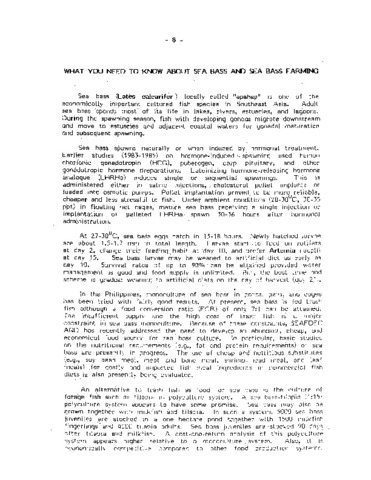Measures of egg quality in induced spawns of the Asian sea bass, Lates calcarifer Bloch
Share
Abstract
The egg morphometry and lipid and protein components were determined in induced spawns (n = 14) of the sea bass, Lates calcarifer, to identify measures of egg quality. Based on fertilization and hatching rates, the spawns were classified either in Group I, (zero fertilization) or Group II (where fertilization and hatching occurred). The egg morphometry did not differ between the two groups (p > 0.05). The total lipid was higher in Group II than in Group I, although the difference was not significant (p > 0.05). The EPA and linoleic acid were significantly higher in Group II (p < 0.05). There were positive correlations between the total saturated fatty acids and fertilization rate (p < 0.05; r = 0.58), the total saturated fatty acids and percentage of normal zygotes (p < 0.02; r = 0.62), and DHA and the percentage of normal zygotes (p < 0.04; r = 0.56). The total protein and FAAs were higher in Group I than in Group II, but the differences were not significant (p > 0.05). Proline, glycine, p-ethanolamine, and aspartic acid were significantly higher in Group II (p < 0.05), while tyrosine and glutamic acid were significantly higher in Group I (p < 0.05). Phosphoserine and fertilization rate were positively correlated (p < 0.03; r = 0.60), as well as aspartic acid and hatching rate (p < 0.05; r = 0.54). Arginine was negatively correlated with fertilization rate (p < 0.03; r = -0.61) and the percentage of normal zygotes (p < 0.03; r = -0.63). Serine was inversely correlated with yolk volume of the newly-hatched larvae (p < 0.03; r = -0.77). The moisture content of the eggs, which was significantly higher in Group II than in Group I (p < 0.03), was directly correlated with the FAAs:protein ratio (p < 0.03; r = 0.76). The present results reveal egg components that may be used as quality measures in induced spawns of sea bass, a euryhaline teleost that spawn pelagic eggs containing an oil globule.
Suggested Citation
Nocillado, J. N., Peñaflorida, V. D., & Borlongan, I. G. (2000). Measures of egg quality in induced spawns of the Asian sea bass, Lates calcarifer Bloch. Fish Physiology and Biochemistry , 22(1), 1-9. https://doi.org/10.1023/A:1007881231664
Subject
Taxonomic term
Collections
- AQD Journal Articles [1249]
Related items
Showing items related by title, author, creator and subject.
-
What are the latest developments in marine hatchery?
Españo, A. J. (Aquaculture Department, Southeast Asian Fisheries Development Center, 2001) -
What you need to know about sea bass and sea bass farming
Southeast Asian Fisheries Development Center, Aquaculture Department (Aquaculture Department, Southeast Asian Fisheries Development Center, 1988) -
Broodstock management and seed production of the rabbitfish Siganus guttatus (Bloch) and the sea bass Lates calcarifer (Bloch)
Duray, Marietta N.; Juario, Jesus V. (Aquaculture Department, Southeast Asian Fisheries Development Center, 1988)This paper reviews results of studies conducted on the rabbitfish, Siganus guttatus (Bloch) and the sea bass Lates calcarifer (Bloch) at the Aquaculture Department of the Southeast Asian Fisheries Development Center. Studies ...




